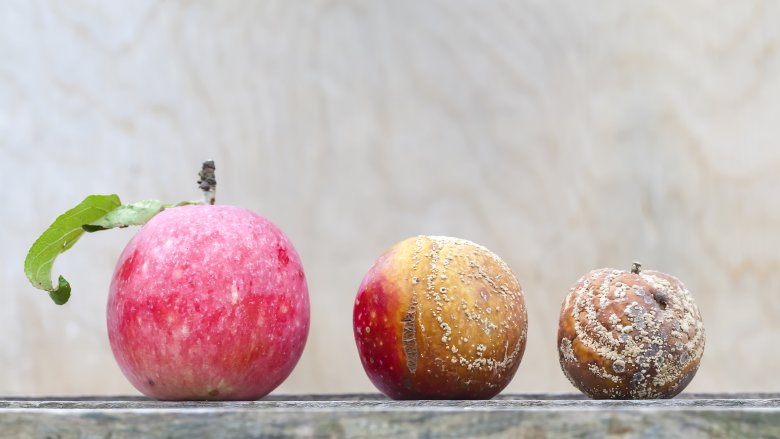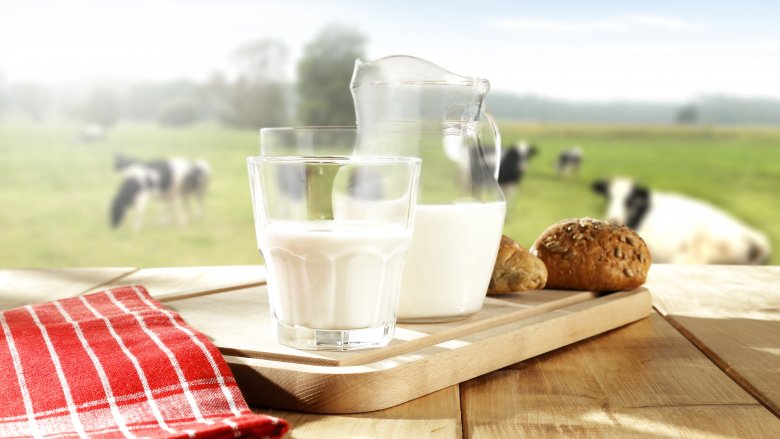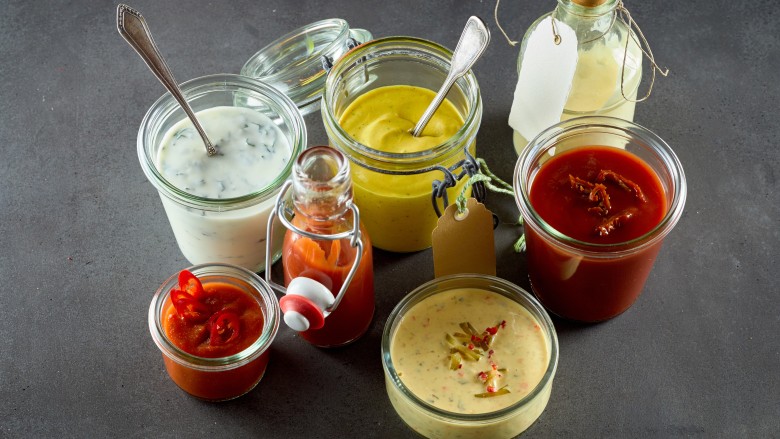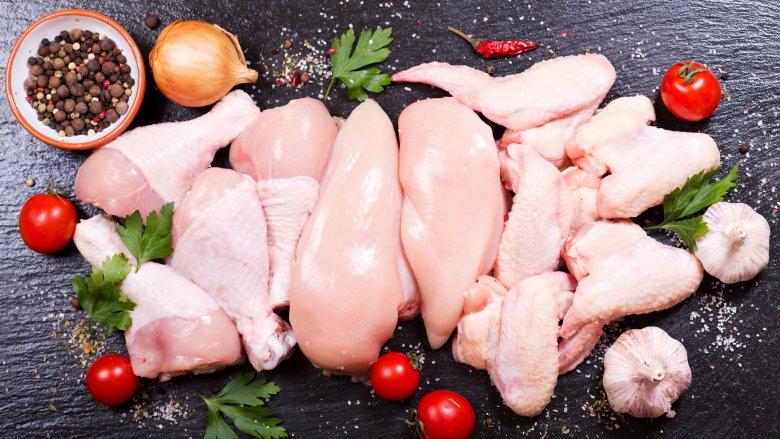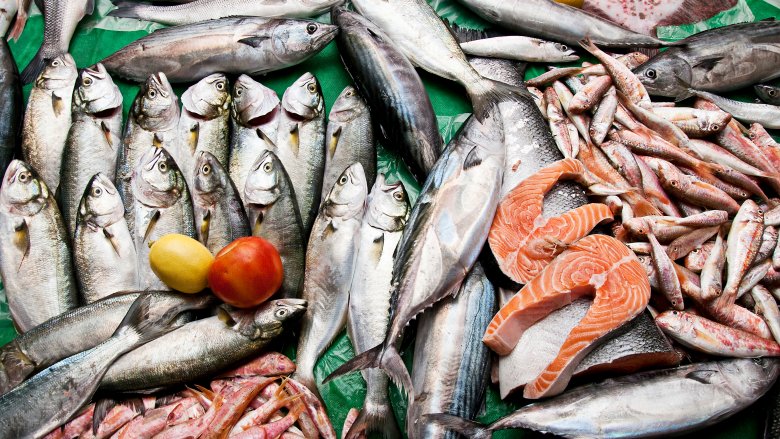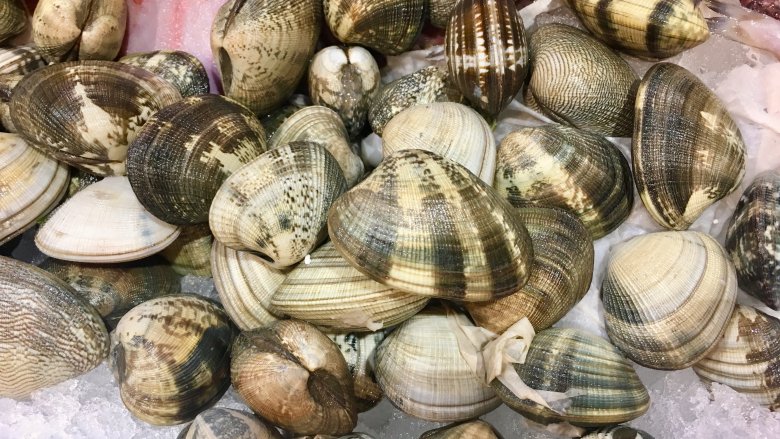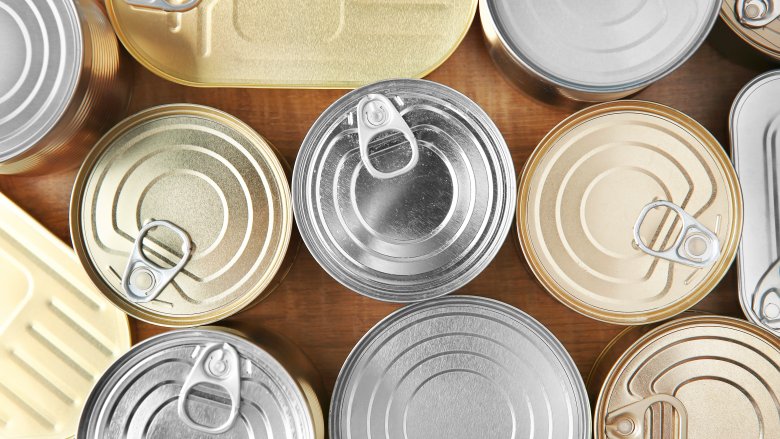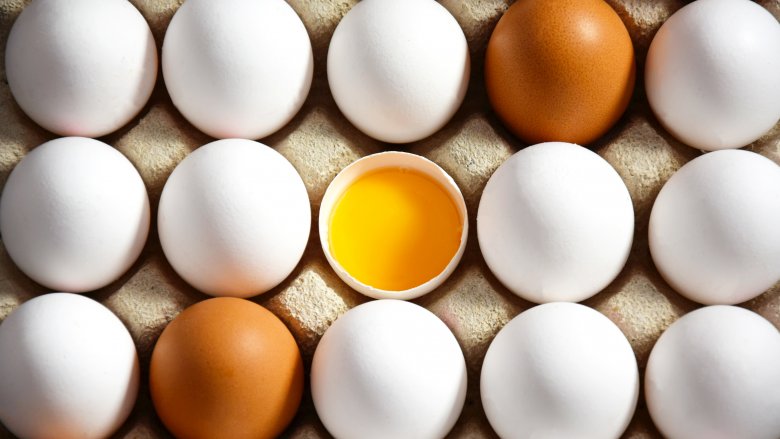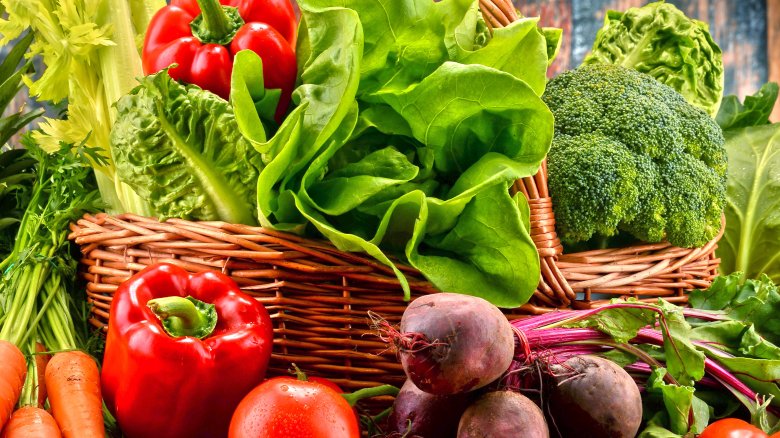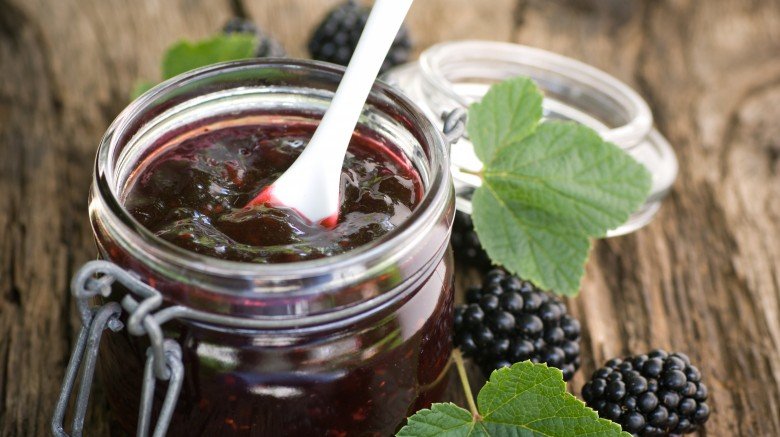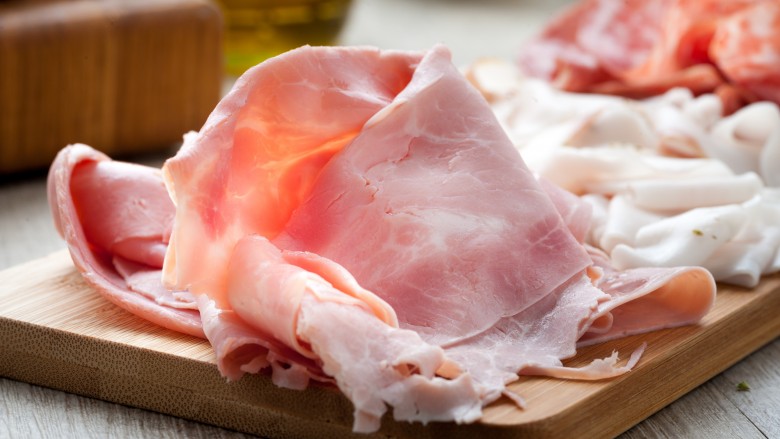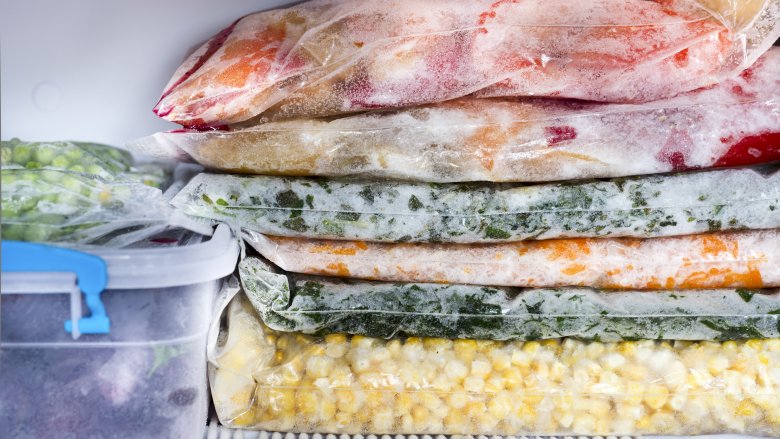Signs Your Food Has Gone Bad
We may receive a commission on purchases made from links.
Anything you pick up at the grocery store comes with a few expiration dates that, in theory, tell you when you should be finishing your food by. Those expiration dates are tricky, though, and they're not always an accurate reflection of whether or not your food's gone bad. Dates err on the side of caution, and there's a huge amount of perfectly good food that's wasted because it's thrown out after the date but before it's actually gone bad.
Food spoilage can go the other way, too, and it's possible your food can turn before the date. That happens when, say, there was a refrigeration issue in the store, or maybe someone in your house left something on the counter and forgot to 'fess up. Whatever the circumstances, eating that spoiled food isn't going to end well for anyone. Let's talk about some ways you can determine whether or not some of your kitchen staples are fine, or if they should be tossed.
Butter
"Wait," you're asking, "butter can go bad? Who keeps butter around long enough for that?" It turns out that butter is kind of complicated, and yes, it absolutely can go bad.
There are two different schools of thought on the best way to store butter: in the fridge or at room temperature. The good news is, your favorite method is not wrong. You just have different things to watch out for depending on your choice. If you keep your butter on the counter, know that it's not only heat but light that's going to make your butter turn rancid faster. That makes ceramic butter crocks practical and fun!
If you're keeping it in the fridge, though, you can expect butter to last about four months. It ultimately goes bad because it's made of a base of cream and will turn rancid if it's left long enough. Even if your butter is pasteurized, there will still be exposure to bacteria, which can cause your butter to go funky. Unsalted butter won't last as long as the salted stuff, and you'll be able to tell it's going off when it starts to smell and taste like something you don't want to be anywhere near.
Milk
When it comes to finding out if your milk's gone off, the best way is still the oldest — give it a sniff. If it smells funky, it's a sign it's spoiled... but "funky" is a bit of a vague term, isn't it?
National Geographic says that if you have trouble with the sniff test, you're not alone. Milk spoils by a complex process involving the microbes that pasteurization misses. The process isn't 100 percent, and the bacteria left behind is what starts eating lactose and excreting lactic acid, which starts a chain reaction resulting in spoilage. But that also means if the surface of your milk starts to look funny, it's separating and going bad.
What about other kinds of dairy? Heavy cream is already separated, and The Balance says that allows it to last for about a month before it starts undergoing the same process as milk (as long as it's unopened). We can also put eggnog in this category, though that's only going to last a short time due to the egg content. Bustle says the sniff test works here, too, and notes it should be an even beige or slightly yellow color. Anything else, and it's bad.
Non-dairy milk
Non-dairy milks are getting more and more popular, and you probably already know they're made in a way that's completely different from milk. Soy milk, says PopSugar, is so stable that an unopened container has a shelf life of an entire year. Once soy and other non-dairy milks are opened, they do go bad. Silk says it's entirely possible for your soy milk to last upwards of a week and a half, but they don't recommend drinking it past day 10.
Figuring out whether your non-dairy milk is bad is a little tricky, and Epicurious talked to nut milk expert Carolyn Flood. She says that unlike dairy milks, the separation you see in non-dairy milks isn't a sign it's bad. Just shake it! You can, however, give it a sniff and a small taste. If it's got a sour tang, smells different than it did when you opened the carton, or is starting to clump, it's spoiled. Spoon University says you can also look at the container. If there's bloat going on there, what's inside has probably turned.
Peanut butter
When you get a craving for peanut butter, there's absolutely nothing that's going to satisfy it aside from a heaping scoop of the stuff, on a spoon or, if you have some restraint, on a sandwich. It's probably one of those jars that sits in your cupboard for a while. Unless you partake regularly, this one might sit a while.
Peanut butter is something of a miracle food, and not just because of the taste. Even at room temperature and even after it's been open, it can last for months without going bad. Part of the reason for its longevity is the combination of high fat and oil content and a weirdly dry nature. That means most bacteria can't even survive in peanut butter, much less thrive there. When it does go bad, it's because it undergoes a process called rancidification. It's a chemical change that's going to change the flavor and smell of the peanut butter, and you'll notice it when it goes bad. If you're peering hopefully into a jar and it looks like it's separating a bit but smells fine, don't worry. That separation is normal, and if you just stir it you'll be good to go. If you do happen to eat some rancid peanut butter, it's not going to actually hurt you or make you sick. You just might you turn your back on peanut butter for a while.
Rice
Rice is one of those kitchen staples that everyone keeps on hand, and chances are good that you have a few different varieties on hand right now. Rice has a reputation as having an indefinite shelf life, as long as it's properly stored, and that's mostly true.
Mostly. While uncooked white, wild, jasmine, basmati, and arborio rice will keep indefinitely as long as they're sealed to keep the pests out, brown rice has a higher oil content and can actually go bad. Uncooked brown rice has a three- to six-month shelf life in the pantry or in the cupboard, a six- to 12-month shelf life in the fridge, and can last from a year to 18 months if you freeze it.
If you're like many people, when you make rice, you make extra. It's handy to keep in the fridge for use in a cup of soup or to throw into whatever you're making for dinner, but cooked rice should only be kept in the fridge for around four to six days. If it's left to sit out at room temperature, it can go bad even faster. Improper storage, or being subjected to a few changes in temperature can cause the growth of a bacteria called Bacillus cereus, and not only is it present in uncooked rice, but it can survive the cooking process. It can also cause food poisoning, so it isn't really something to mess around with. If your rice is starting to smell a little off or if it seems crunchier or drier than you think it should be, play it safe and chuck it in the compost.
Red meat
It's safe to say that you expect red meats to be, well, red. That color, says the United States Department of Agriculture, comes from the interaction between meat's protein and oxygen. They also say it's perfectly normal for the color of fresh meat to change, and that the change doesn't necessarily mean it's going bad. If your steak is turning a brownish-red, it's fine (that's just from the protein's continued reaction with the air), and if the center is brown, that's fine, too. Brown centers happen because oxygen doesn't penetrate that far into the meat. An iridescent sheen doesn't always mean it's bad, either — that's just the light reacting with things like iron and fat.
There are some color changes that hint at spoilage, though. If your meat looks faded or very, very dark, that's a sign it's aging past the time it's safe to eat. Don't judge just by that. The USDA says spoiled red meat will be starting to smell off, and that you'll also need to touch it. If the surface has turned tacky, sticky, or has developed a slimy coating, find something else for dinner.
Condiments
Condiments are tricky, just because of the sheer volume of fun things that are taking over entire aisles at the grocery store. It's easy to open one, throw it in the door of the fridge and forget about it, especially given that a lot of them contain things like salt and vinegar and seem like they last forever.
There's a huge difference in how long opened condiments will last in the fridge. One of the most common is ketchup, which can last about six months before it really starts to turn. A change in color or even texture isn't necessarily a sign that it's gone bad, but if it starts to smell a little funny or if mold starts to develop, it's time to pick up a fresh bottle. That's a pretty tried-and-true way of telling when things go off. Some things — like salsa — will start to turn after only a few days, while things like mustard can be good for up to a year.
But what about condiment packets? It just seems wrong to throw out those little packets of soy sauce you get every time you order out for Chinese or those salt packets you grab (but rarely use) for your McDonald's fries. While salt, sugar, and honey packets will be good basically forever, others do go bad. They're going to start to smell funky when they do, and that can be anywhere from a year (for things like mayo and tartar sauce) to four years (for hot sauces and vinegars) after you brought them home. If you aren't sure how long they've been around, you might want to play it safe.
Poultry
There's such a wide range of birds and breeds that are raised for the dinner table it's difficult to tell the good from the bad based on color alone. The USDA says raw poultry can range from a bluish-white to yellow, and there can be visible differences even between birds of the same breed. That doesn't always mean one's bad, it might just mean one bird got more exercise than another. Really!
Darkening around the bones and different shades of pink and red in ground poultry are perfectly normal — and completely safe. What's not safe is when it starts to smell funky, and that's one of the most noticeable signs your birds are going bad. Confirm by touching the raw poultry (while, of course, keeping in mind your basic food safety and washing your hands afterward). If there's a bit of slime that's starting to develop, if it sticks to your fingers, or if it has a tacky texture, it's time to toss it.
Fish
Fish is delicious and it's usually pretty good for you, but the prospect of getting bad fish is terrifying. Fortunately, there's a system in place to keep that from happening, and it's called the Hazard Analysis Critical Control Point. The University of Rhode Island says the program oversees the processing of fish from start to finish, so what can you do to make sure it stays safe?
They say that fresh fish is super perishable, to the point where it should be one of the last things you pick up before you finish your shopping. It's only going to last a day once you get it home (perhaps two), so you should be careful with it starting with when you pick it out at the store. Only choose fish that's cold to the touch and that doesn't have a smell — that fishy smell that turns your stomach is actually a sign it's starting to go bad. Think of walking on a beach. A healthy, clean beach smells like the sea, right? It's only when dead fish start washing up that you get that funk, and if you smell that funk coming off your dinner, give it a pass.
Shellfish
Getting bad shellfish will ruin your life for days, so let's talk preventative measures and how you should know when to send it back or chuck it out. One of the biggest signs something's up is when you buy it and it's already dead. According to The University of Rhode Island, shellfish dealers should keep certification tags that tell just how long it's been since they were harvested, and you should always buy live.
When it comes to oysters, clams, and mussels, be suspicious of open shells. If they stay open when you tap them, the creature inside is dead and it should be tossed. During the cooking process, all the shells should open. If they don't, they're bad or have been improperly heated, and shouldn't be eaten.
SFGate says there's a few other things you can look for. Shellfish should have a mild smell, and a strong or fishy scent is a sign they've gone off. The meat of the shellfish should also be plump, and if they're dry or showing some discoloration, don't eat them.
Canned food
Watch any television show or movie set in the post-apocalyptic, dystopian future, and chances are you'll see them raiding stores for canned goods. But canned goods aren't a 100 percent guarantee — not even chocolate pudding — and it's possible they've spoiled.
There are a few things at work here, and the first is the can itself. If the can is dented, corroded, broken, or there's even the slightest of compromises in the can's structure (via io9), that's going to contaminate whatever's inside, and negate the preservation process the food's gone through. That's true for both commercial and home-canned products, and if you're worried about preserves you jarred yourself, check the lid first. If that's not properly sealed, don't eat it.
If you're still in doubt, here's a bit of trivia that might also help. Non-acidic canned goods (like soups) will last much longer than acidic foods like fruits and tomatoes, so there's a much higher chance that your fruit cocktail is bad. You're better off with the pudding.
Eggs
You've probably heard that when an egg floats, it's bad. That's not entirely true, and according to the USDA, a floating egg has just progressed to the next stage of usable life.
Let's explain. When an egg is laid, there's no air inside. As it cools, though, parts of the egg contract and other parts don't. The space between is filled with air, and as the egg ages, there's a reaction inside between the yolk and the white. The porous shell allows more air to enter the egg, it becomes more fragile, the yolk shifts, and the white thins. None of that means it's actually bad.
The more air that's in the egg, the older it is and the more likely it is to float. But age doesn't mean it's no longer usable, and in order to tell if it's safe to use, you'll need to crack it. Spoiled eggs will give off an unmistakable odor, and they'll keep that odor even after they've been cooked, too. You'll never have to wonder at a restaurant again.
Vegetables
Thanks to social media, we've gotten used to having pretty food. That means we can be poorly equipped to decide what's actually gone bad based on appearance, since imperfect doesn't mean spoiled. The Greater Chicago Food Depository put together some great guidelines on how to tell if something is actually bad, so let's talk veggies.
Basically, vegetables that have gone completely discolored, soft, and rotten through the core are bad. Veggies with mold or that are developing slime are bad, too, but not all typical signs of spoilage actually mean veggies have turned. Wilted lettuce, celery, and leafy greens are usually fine if you take off the outer layers, while the flesh of cucumbers, zucchini, and squash might be perfectly fine once you cut away discolored or imperfect hard skin. Sprouting onions and potatoes are also fine, just cut away the sprouts. Potatoes in particular can be incredibly deceiving, as their skin is prone to developing what might look like mold or signs of rot. As long as they're kept in a dry place, they have a super long shelf life. Peel them even if they look funky, they might be fine.
Fruit
The Greater Chicago Food Depository put together a series of guidelines on when you should keep, salvage, and toss fruits, too. It can be surprisingly complicated, and bananas are the perfect example of that. Even when they turn black, they're still perfectly safe and they'll make the best banana bread you've ever had.
Citrus fruits are only bad if they're rotten all the way through, and you can't tell whether or not that's the case until you cut them open. Bruised fruits aren't bad, either, although you want to cut away the discolored bits. If there's a bit of mold that's starting to grow on things like berries, cherries, and grapes, it's only the moldy ones that are bad — the rest can still be eaten after a complete rinse.
If you're wondering when you should throw the whole thing away, that's only when there's a texture change through the whole fruit. Spoiled fruit will go squishy, soft, and wrinkled, and will probably start to smell a little funky. But again, if it's a thick-skinned fruit, don't make any judgement calls until you cut it open.
Jams and jellies
Jams and jellies are a staple in most refrigerators, and unfortunately, they're often a staple mystery item. If you don't use them regularly, it's easy to forget just how long that jar has taken to migrate from the door to the shelf to the back of the fridge.
There are a couple ways you can tell that your jellies and jams are going bad, and the most obvious sign is that mold is starting to grow. Check the jelly and the inside of the lid, and if you find any signs of mold, the National Center for Home Food Preservation says that you should toss the whole thing. If you're the frugal type who debates about just scooping out the moldy bits, that probably won't work. Mold can produce something called a mycotoxin, and if you eat any of that, it's going to ruin your day.
Jams and jellies can also ferment, and this is a pretty common thing in reduced-sugar versions. Sure, they might be healthier, but they're also prone to fermenting faster. Fermentation can also happen when the jar isn't sealed or if it wasn't processed right. If that happens, it'll make the jam taste slightly off. If you're worried about color change, though, that doesn't necessarily mean that anything's going bad, and it's something that's known to happen with jams and jellies while they're still perfectly fine.
Mushrooms
Mushrooms already have a bit of a questionable reputation, they're already funky-smelling, and they always have a bit of an odd texture. You can still tell when they start to spoil, and according to Delishably, there are a few key things to look for.
Mushrooms should be used before they pass the two week mark, as that's when they're going to start to show some signs they're well past their prime. Look for wrinkles on the caps, a change in color, the development of dark spots, a weird smell, and — this one's a dead giveaway — see if there's any slime developing. That slime is sometimes the first thing to happen (especially if you keep your mushrooms in the fridge), so consider that your earliest warning sign. Getting darker is another early indication they're on their way out, but at this point, you can still probably use them. Their days are numbered, though, so it's time to get sauteing.
Cheese
Cheese is a tough one, not just because there are so many different kinds of cheese, but because there are so many different smells and flavors. (And let's be honest — some of them smell pretty bad to begin with.) Fortunately, you can divide most cheeses into three different groups for lifespan purposes.
Hard cheeses, like cheddar and Parmesan, can last up to six months in the fridge. Even if they start to grow a bit of mold on them, you can safely cut the mold off these cheeses and eat the rest, most of the time. Normal mold will be bluish-green or white, but if it's any other color, it's probably better to throw it away. Soft cheeses are things like cream cheese, mozzarella, feta, and Camembert, and these cheeses go bad pretty quickly because of their moisture content. These will start to mold when they begin to turn, and if there's any mold, the entire thing should be destined for the garbage.
Everything else is somewhere in the middle; the best way to tell if it's starting to go off is to take a whiff. Cheese that's turning will start to smell — and taste — differently than it did when you first opened the package. Mold is one of the first signs it's starting to go. If there's not too much mold, feel free to cut it off and save the rest, but know that the end is near for this one.
Pasta
It's tough to tell when dry pasta has gone bad because it isn't going to show any outward signs of spoilage like many foods do. While it probably won't mold, it will turn pretty tasteless as it ages past its expiration date. And while you probably know by now that expiration dates aren't all they're cracked up to be, you can use them as a general guideline for whether you should use that pasta in the special dish you're planning.
If you're wondering whether or not the fresh pasta in your fridge has gone bad, the answer is probably "yes" if you have to think about it. Fresh pasta is typically only good for a few days. Mold or discoloration are sure signs it's gone past the point of no return.
Olive oil
First, let's clarify that this is about extra-virgin olive oil rather than the refined stuff. (If you're serious about your cooking, that's probably what you have anyway.) Other, non-virgin olive oils have different qualities and different things added to extend their shelf life, but the freshness of extra-virgin olive oil is something that's taken so seriously there's a committee dedicated to the product. It's the International Olive Council, and it helps set guidelines on the qualities of olive oil that are going to help keep it top of the line.
The science of olive oil spoiling is some technical stuff based on a group of compounds called polyphenols. Those are what give olive oil all its good qualities, and when the oil is exposed to heat and air, the polyphenols start disappearing. (If you want to get technical, the process is called "tiring.")
While you can't exactly test for polyphenols, you can get familiar with the smell of your favorite olive oil. Rancid olive oil has a very distinctive smell, one that's likened to Elmer's glue or a sickeningly sweet aroma. The farther gone the olive oil is, the stronger it will be. To make sure it's not just the olive oil around the cap or top of the bottle that's gone bad, pour some out and take a big whiff. It's also perfectly safe to taste. Take a tablespoon of room temperature oil and try it. If there's no taste, it's time for a new bottle.
Lunch meat
Who doesn't love a nice, fresh sandwich piled high with fresh deli cold cuts, some cheese, and fresh veg? But bad lunch meat can ruin more than just your lunch. If you've ever debated whether to use that last bit of turkey or ham in the fridge, you're not alone.
Most cold cuts will last three to five days once they've been opened, or ten days past the sell-by date that was marked by the deli where they were sliced. In addition to the growth of mold, look at the texture of the meat. If it's starting to go bad, it could have a slightly slimy texture that could make a whole lot of things wrong with your sandwich. It might start to smell a bit off, too, and deli meats going bad will often start to smell of vinegar or ammonia. In that case, give them a pitch and stick with PB&J.
Frozen foods
Freezing is a great way to extend the life of your food, but not all freezers were created equal. The USDA says if you freeze food and keep it at a consistent temperature, it's never going to go bad. There's a caveat, though, and they also say that the longer something is frozen, the greater the decline in food quality.
Home freezers aren't the same as commercial ones, and what if there's a power outage or someone leaves the door open? It's entirely possible for extreme fluctuations in temperature to ruin a freezer full of food. If you leave the door shut, you should be good for as long as two days without power. But, if food has completely or mostly thawed, no longer has ice crystals, or is above 40 degrees, you should get rid of the whole thing. Carefully arranging your freezer is important, too. Put meat and poultry on the bottom, as juice might start to leak during a thaw. If it does, throw away whatever it's contaminated.
It's also possible that frozen food, once thawed, might start to smell funky. If it does, toss it and move on to your dinnertime backup plan.
